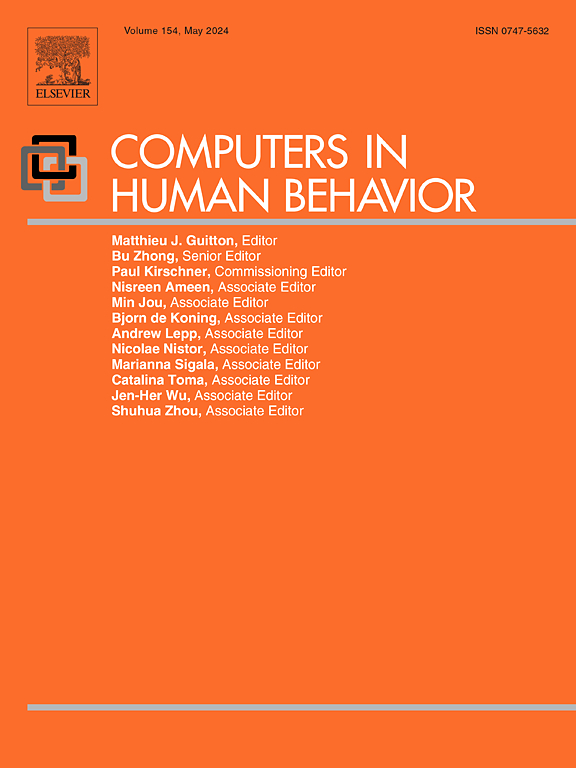促进对家庭媒体生态在儿童中期焦虑和抑郁中的作用的理解:什么最重要?
IF 8.9
1区 心理学
Q1 PSYCHOLOGY, EXPERIMENTAL
引用次数: 0
摘要
目前关于数字设备和儿童心理健康的研究往往忽视了更广泛的家庭媒体生态,而倾向于单一的“屏幕时间”衡量标准。目前尚不清楚家庭媒体生态的某些方面(即设备类型、环境、父母监控)是否对儿童的心理健康更有影响。为了弥补这一差距,这项多信息来源的研究使用了1140名儿童(48%是女孩)及其母亲的前瞻性队列,并收集了大流行前(8岁)和大流行期间(9.7岁和10.4岁)的数据。母亲们完成了关于孩子在大流行前的焦虑和抑郁症状、大流行数字设备使用情况、对孩子数字活动的认识、有关设备的家庭规则以及自己的技术使用情况的调查问卷。儿童报告了他们的大流行焦虑和抑郁症状、设备内容(例如,流媒体、游戏)和环境(例如,单独使用、睡前设备),以及他们对母亲使用技术的看法。回归模型对儿童在10岁时报告的抑郁和焦虑进行了前瞻性评估。在控制了大流行前的焦虑和抑郁后,屏幕时间与更严重的抑郁(β = 0.13, 95% CI[0.05, 0.21])和焦虑(β = 0.12, 95% CI[0.04, 0.19])症状相关。儿童(但不是母亲报告的)母亲技术干预与儿童抑郁(β = 0.19, 95% CI[0.12, 0.26])和焦虑(β = 0.14, 95% CI[0.07, 0.20])症状增加相关。发短信与焦虑症状增加有关,尤其是女孩(β = 0.08, 95% CI[0.02, 0.15])。这些发现强调了研究中多方面的屏幕时间指标的必要性,并在讨论数字设备使用时涉及不同家庭的观点。本文章由计算机程序翻译,如有差异,请以英文原文为准。
Advancing understanding of the role of the family media ecology on child anxiety and depression in middle childhood: What matters most?
Current research on digital devices and children's mental health often overlooks the broader family media ecology in favour of a monolithic measure of “screen time”. It remains unclear whether certain aspects of the family media ecology (i.e., device type, context, parental monitoring) are more consequential for children's mental health. To address this gap, this multi-informant study used a prospective cohort of 1140 children (48 % girls) and their mothers with data collected pre-pandemic (age 8) and during the pandemic (ages 9.7 and 10.4). Mothers completed questionnaires about their child's pre-pandemic anxiety and depression symptoms, as well as pandemic digital device use, awareness of their child's digital activities, household rules regarding devices, and their own technoference. Children reported on their pandemic anxiety and depression symptoms, device content (e.g., streaming, gaming) and contexts (e.g., solitary use, devices before bed), and their perceptions of maternal technoference. Regression models prospectively assessed child-reported depression and anxiety at age 10. After controlling for pre-pandemic anxiety and depression, screen time was associated with greater depression (β = 0.13, 95 % CI [0.05, 0.21]) and anxiety (β = 0.12, 95 % CI [0.04, 0.19]) symptoms. Child (but not mother-reported) maternal technoference was associated with increased child depression (β = 0.19, 95 % CI [0.12, 0.26]) and anxiety (β = 0.14, 95 % CI [0.07, 0.20]) symptoms. Text messaging was associated with increased anxiety symptoms, particularly for girls (β = 0.08, 95 % CI [0.02, 0.15]). These findings underscore the necessity of multi-faceted screen time metrics in research and involving diverse family perspectives in discussions about digital device use.
求助全文
通过发布文献求助,成功后即可免费获取论文全文。
去求助
来源期刊

Computers in Human Behavior
Multiple-
CiteScore
19.10
自引率
4.00%
发文量
381
审稿时长
40 days
期刊介绍:
Computers in Human Behavior is a scholarly journal that explores the psychological aspects of computer use. It covers original theoretical works, research reports, literature reviews, and software and book reviews. The journal examines both the use of computers in psychology, psychiatry, and related fields, and the psychological impact of computer use on individuals, groups, and society. Articles discuss topics such as professional practice, training, research, human development, learning, cognition, personality, and social interactions. It focuses on human interactions with computers, considering the computer as a medium through which human behaviors are shaped and expressed. Professionals interested in the psychological aspects of computer use will find this journal valuable, even with limited knowledge of computers.
 求助内容:
求助内容: 应助结果提醒方式:
应助结果提醒方式:


